Application of Quality of Life in Human Resource Management
VerifiedAdded on 2021/04/24
|7
|2022
|29
Essay
AI Summary
This essay examines the crucial role of human resource management (HRM) in enhancing employee quality of life (QWL) within organizations. It defines QWL as the extent to which employees' personal needs are met through their work experiences, emphasizing its direct influence on job satisfaction, performance, and overall well-being. The essay identifies key factors impacting QWL, such as fair compensation, growth opportunities, a safe environment, and social integration. It argues that effective HRM practices, including recruitment, compensation, training, and workplace safety, are essential for fostering a positive work environment. The essay provides examples, such as Google's employee benefits, to illustrate how organizations can implement strategic policies to improve QWL and, consequently, organizational performance. The conclusion highlights the significance of HRM in shaping employee experiences and driving company growth.
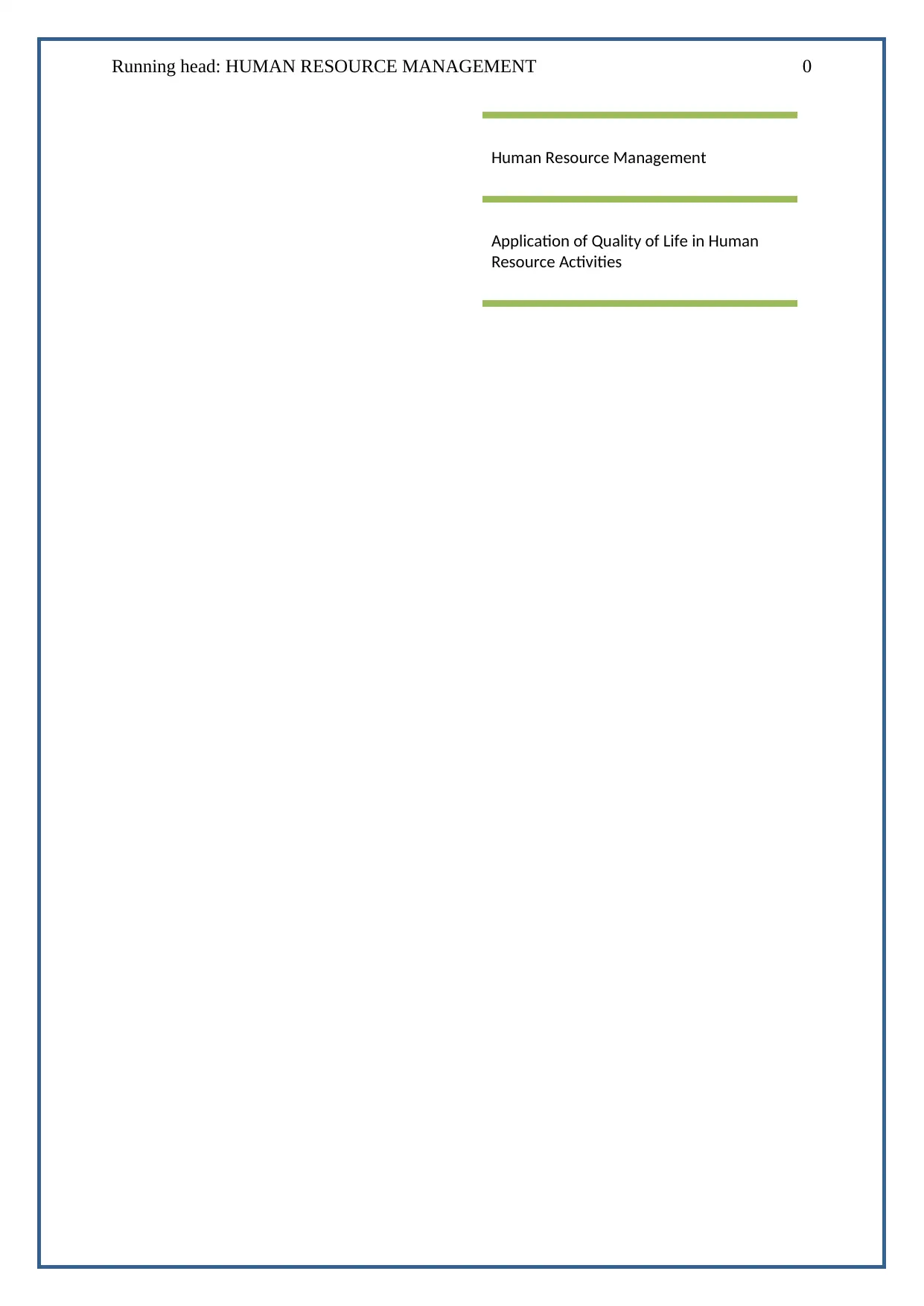
Running head: HUMAN RESOURCE MANAGEMENT 0
Human Resource Management
Application of Quality of Life in Human
Resource Activities
Human Resource Management
Application of Quality of Life in Human
Resource Activities
Paraphrase This Document
Need a fresh take? Get an instant paraphrase of this document with our AI Paraphraser
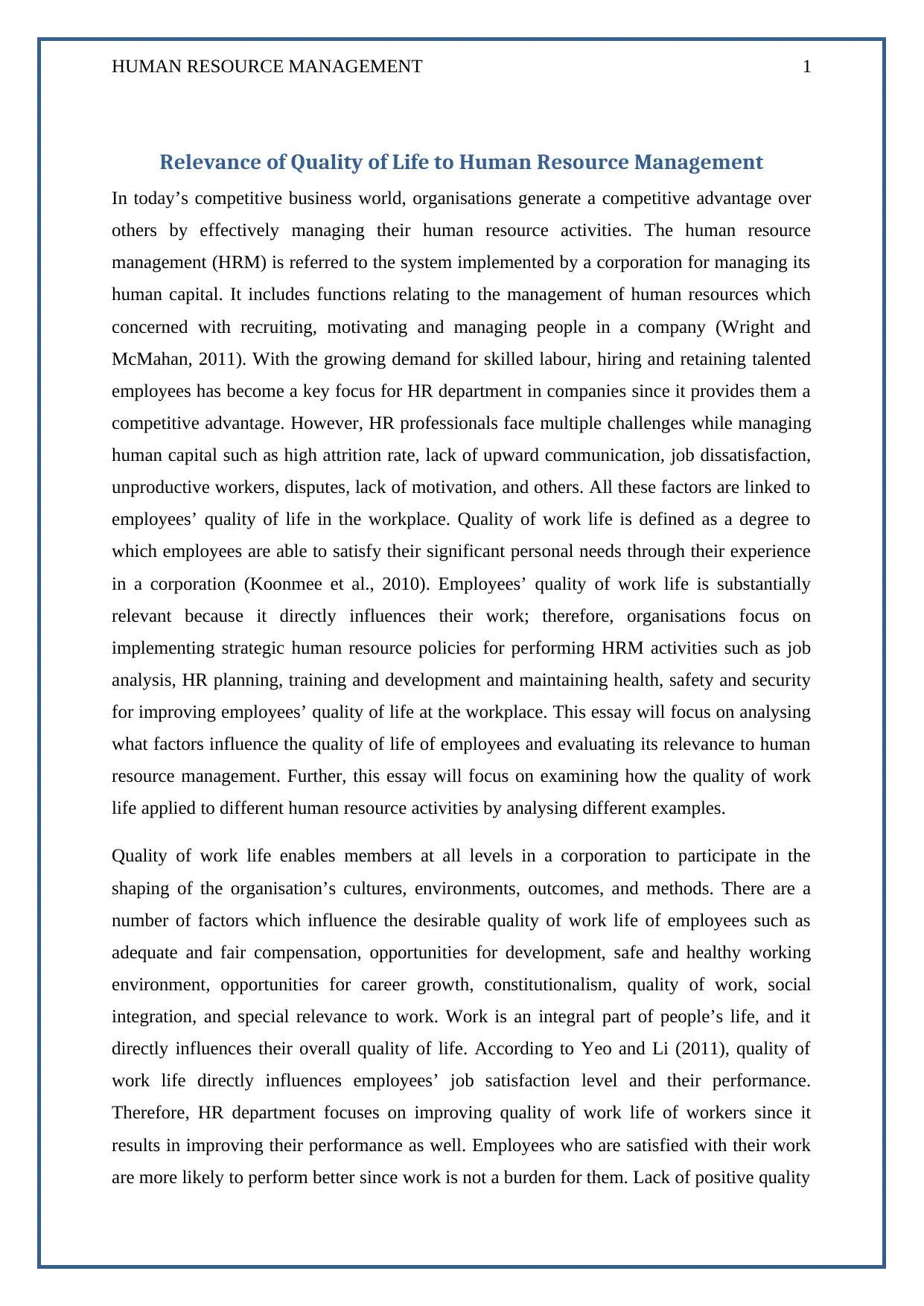
HUMAN RESOURCE MANAGEMENT 1
Relevance of Quality of Life to Human Resource Management
In today’s competitive business world, organisations generate a competitive advantage over
others by effectively managing their human resource activities. The human resource
management (HRM) is referred to the system implemented by a corporation for managing its
human capital. It includes functions relating to the management of human resources which
concerned with recruiting, motivating and managing people in a company (Wright and
McMahan, 2011). With the growing demand for skilled labour, hiring and retaining talented
employees has become a key focus for HR department in companies since it provides them a
competitive advantage. However, HR professionals face multiple challenges while managing
human capital such as high attrition rate, lack of upward communication, job dissatisfaction,
unproductive workers, disputes, lack of motivation, and others. All these factors are linked to
employees’ quality of life in the workplace. Quality of work life is defined as a degree to
which employees are able to satisfy their significant personal needs through their experience
in a corporation (Koonmee et al., 2010). Employees’ quality of work life is substantially
relevant because it directly influences their work; therefore, organisations focus on
implementing strategic human resource policies for performing HRM activities such as job
analysis, HR planning, training and development and maintaining health, safety and security
for improving employees’ quality of life at the workplace. This essay will focus on analysing
what factors influence the quality of life of employees and evaluating its relevance to human
resource management. Further, this essay will focus on examining how the quality of work
life applied to different human resource activities by analysing different examples.
Quality of work life enables members at all levels in a corporation to participate in the
shaping of the organisation’s cultures, environments, outcomes, and methods. There are a
number of factors which influence the desirable quality of work life of employees such as
adequate and fair compensation, opportunities for development, safe and healthy working
environment, opportunities for career growth, constitutionalism, quality of work, social
integration, and special relevance to work. Work is an integral part of people’s life, and it
directly influences their overall quality of life. According to Yeo and Li (2011), quality of
work life directly influences employees’ job satisfaction level and their performance.
Therefore, HR department focuses on improving quality of work life of workers since it
results in improving their performance as well. Employees who are satisfied with their work
are more likely to perform better since work is not a burden for them. Lack of positive quality
Relevance of Quality of Life to Human Resource Management
In today’s competitive business world, organisations generate a competitive advantage over
others by effectively managing their human resource activities. The human resource
management (HRM) is referred to the system implemented by a corporation for managing its
human capital. It includes functions relating to the management of human resources which
concerned with recruiting, motivating and managing people in a company (Wright and
McMahan, 2011). With the growing demand for skilled labour, hiring and retaining talented
employees has become a key focus for HR department in companies since it provides them a
competitive advantage. However, HR professionals face multiple challenges while managing
human capital such as high attrition rate, lack of upward communication, job dissatisfaction,
unproductive workers, disputes, lack of motivation, and others. All these factors are linked to
employees’ quality of life in the workplace. Quality of work life is defined as a degree to
which employees are able to satisfy their significant personal needs through their experience
in a corporation (Koonmee et al., 2010). Employees’ quality of work life is substantially
relevant because it directly influences their work; therefore, organisations focus on
implementing strategic human resource policies for performing HRM activities such as job
analysis, HR planning, training and development and maintaining health, safety and security
for improving employees’ quality of life at the workplace. This essay will focus on analysing
what factors influence the quality of life of employees and evaluating its relevance to human
resource management. Further, this essay will focus on examining how the quality of work
life applied to different human resource activities by analysing different examples.
Quality of work life enables members at all levels in a corporation to participate in the
shaping of the organisation’s cultures, environments, outcomes, and methods. There are a
number of factors which influence the desirable quality of work life of employees such as
adequate and fair compensation, opportunities for development, safe and healthy working
environment, opportunities for career growth, constitutionalism, quality of work, social
integration, and special relevance to work. Work is an integral part of people’s life, and it
directly influences their overall quality of life. According to Yeo and Li (2011), quality of
work life directly influences employees’ job satisfaction level and their performance.
Therefore, HR department focuses on improving quality of work life of workers since it
results in improving their performance as well. Employees who are satisfied with their work
are more likely to perform better since work is not a burden for them. Lack of positive quality
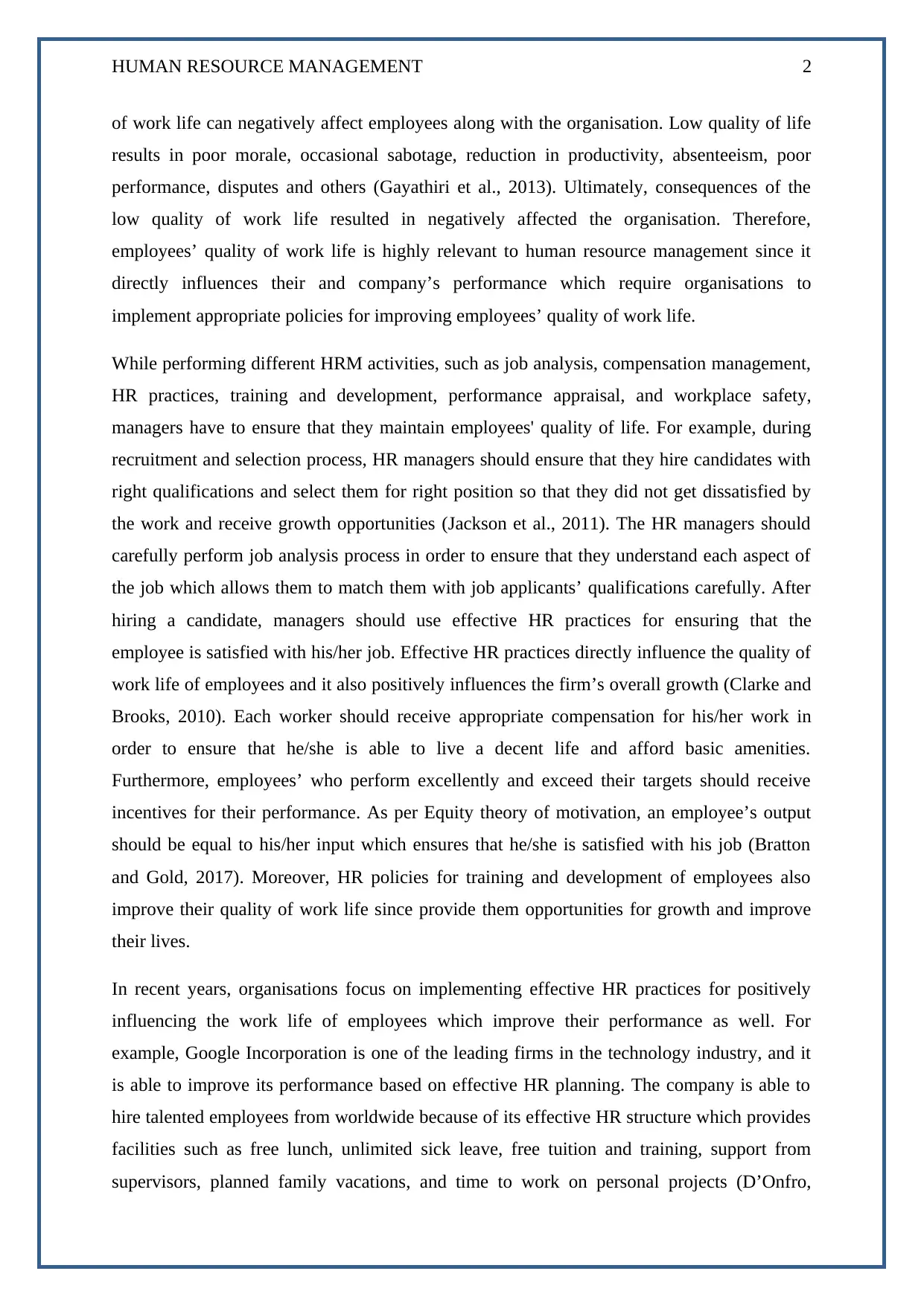
HUMAN RESOURCE MANAGEMENT 2
of work life can negatively affect employees along with the organisation. Low quality of life
results in poor morale, occasional sabotage, reduction in productivity, absenteeism, poor
performance, disputes and others (Gayathiri et al., 2013). Ultimately, consequences of the
low quality of work life resulted in negatively affected the organisation. Therefore,
employees’ quality of work life is highly relevant to human resource management since it
directly influences their and company’s performance which require organisations to
implement appropriate policies for improving employees’ quality of work life.
While performing different HRM activities, such as job analysis, compensation management,
HR practices, training and development, performance appraisal, and workplace safety,
managers have to ensure that they maintain employees' quality of life. For example, during
recruitment and selection process, HR managers should ensure that they hire candidates with
right qualifications and select them for right position so that they did not get dissatisfied by
the work and receive growth opportunities (Jackson et al., 2011). The HR managers should
carefully perform job analysis process in order to ensure that they understand each aspect of
the job which allows them to match them with job applicants’ qualifications carefully. After
hiring a candidate, managers should use effective HR practices for ensuring that the
employee is satisfied with his/her job. Effective HR practices directly influence the quality of
work life of employees and it also positively influences the firm’s overall growth (Clarke and
Brooks, 2010). Each worker should receive appropriate compensation for his/her work in
order to ensure that he/she is able to live a decent life and afford basic amenities.
Furthermore, employees’ who perform excellently and exceed their targets should receive
incentives for their performance. As per Equity theory of motivation, an employee’s output
should be equal to his/her input which ensures that he/she is satisfied with his job (Bratton
and Gold, 2017). Moreover, HR policies for training and development of employees also
improve their quality of work life since provide them opportunities for growth and improve
their lives.
In recent years, organisations focus on implementing effective HR practices for positively
influencing the work life of employees which improve their performance as well. For
example, Google Incorporation is one of the leading firms in the technology industry, and it
is able to improve its performance based on effective HR planning. The company is able to
hire talented employees from worldwide because of its effective HR structure which provides
facilities such as free lunch, unlimited sick leave, free tuition and training, support from
supervisors, planned family vacations, and time to work on personal projects (D’Onfro,
of work life can negatively affect employees along with the organisation. Low quality of life
results in poor morale, occasional sabotage, reduction in productivity, absenteeism, poor
performance, disputes and others (Gayathiri et al., 2013). Ultimately, consequences of the
low quality of work life resulted in negatively affected the organisation. Therefore,
employees’ quality of work life is highly relevant to human resource management since it
directly influences their and company’s performance which require organisations to
implement appropriate policies for improving employees’ quality of work life.
While performing different HRM activities, such as job analysis, compensation management,
HR practices, training and development, performance appraisal, and workplace safety,
managers have to ensure that they maintain employees' quality of life. For example, during
recruitment and selection process, HR managers should ensure that they hire candidates with
right qualifications and select them for right position so that they did not get dissatisfied by
the work and receive growth opportunities (Jackson et al., 2011). The HR managers should
carefully perform job analysis process in order to ensure that they understand each aspect of
the job which allows them to match them with job applicants’ qualifications carefully. After
hiring a candidate, managers should use effective HR practices for ensuring that the
employee is satisfied with his/her job. Effective HR practices directly influence the quality of
work life of employees and it also positively influences the firm’s overall growth (Clarke and
Brooks, 2010). Each worker should receive appropriate compensation for his/her work in
order to ensure that he/she is able to live a decent life and afford basic amenities.
Furthermore, employees’ who perform excellently and exceed their targets should receive
incentives for their performance. As per Equity theory of motivation, an employee’s output
should be equal to his/her input which ensures that he/she is satisfied with his job (Bratton
and Gold, 2017). Moreover, HR policies for training and development of employees also
improve their quality of work life since provide them opportunities for growth and improve
their lives.
In recent years, organisations focus on implementing effective HR practices for positively
influencing the work life of employees which improve their performance as well. For
example, Google Incorporation is one of the leading firms in the technology industry, and it
is able to improve its performance based on effective HR planning. The company is able to
hire talented employees from worldwide because of its effective HR structure which provides
facilities such as free lunch, unlimited sick leave, free tuition and training, support from
supervisors, planned family vacations, and time to work on personal projects (D’Onfro,
⊘ This is a preview!⊘
Do you want full access?
Subscribe today to unlock all pages.

Trusted by 1+ million students worldwide
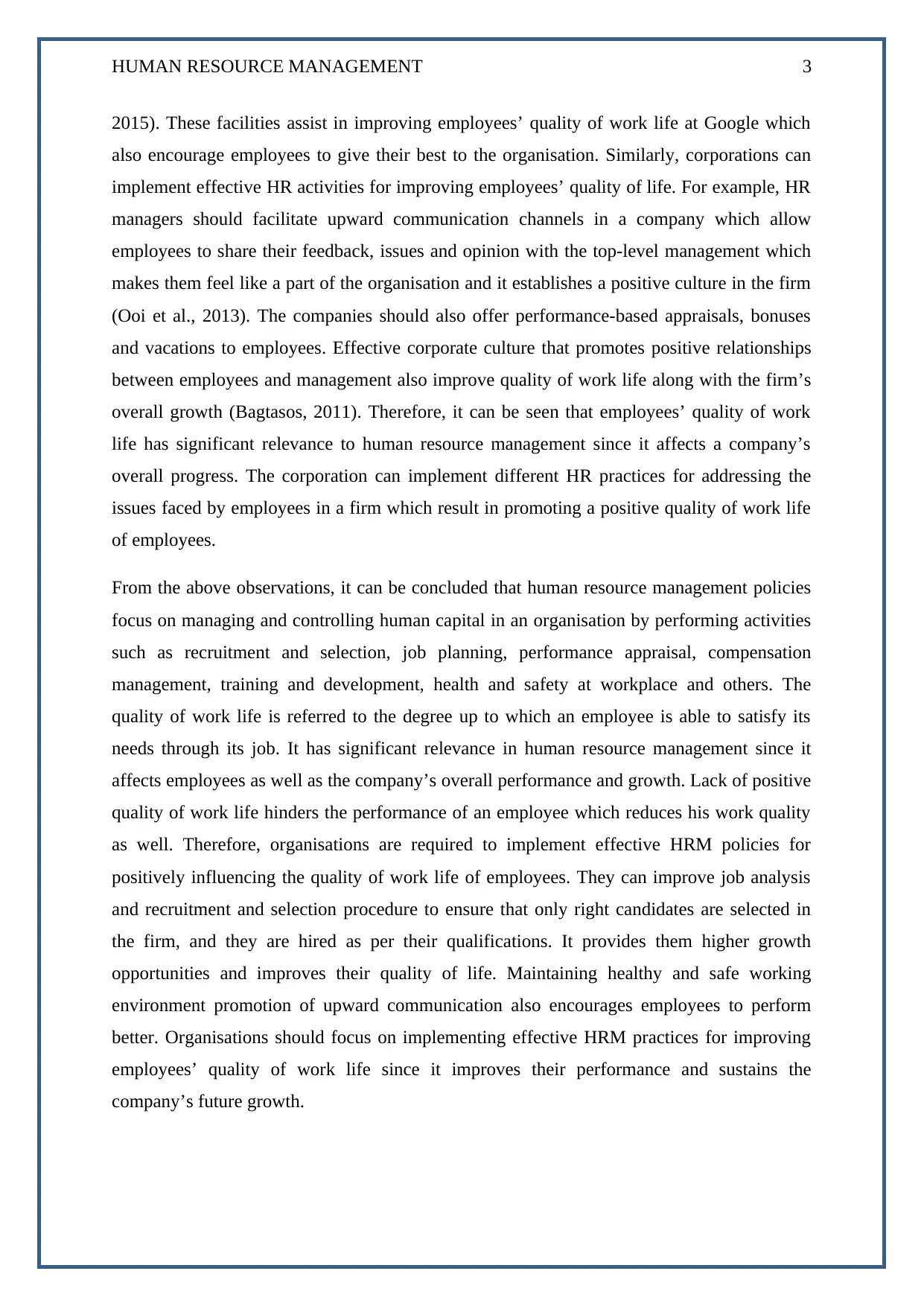
HUMAN RESOURCE MANAGEMENT 3
2015). These facilities assist in improving employees’ quality of work life at Google which
also encourage employees to give their best to the organisation. Similarly, corporations can
implement effective HR activities for improving employees’ quality of life. For example, HR
managers should facilitate upward communication channels in a company which allow
employees to share their feedback, issues and opinion with the top-level management which
makes them feel like a part of the organisation and it establishes a positive culture in the firm
(Ooi et al., 2013). The companies should also offer performance-based appraisals, bonuses
and vacations to employees. Effective corporate culture that promotes positive relationships
between employees and management also improve quality of work life along with the firm’s
overall growth (Bagtasos, 2011). Therefore, it can be seen that employees’ quality of work
life has significant relevance to human resource management since it affects a company’s
overall progress. The corporation can implement different HR practices for addressing the
issues faced by employees in a firm which result in promoting a positive quality of work life
of employees.
From the above observations, it can be concluded that human resource management policies
focus on managing and controlling human capital in an organisation by performing activities
such as recruitment and selection, job planning, performance appraisal, compensation
management, training and development, health and safety at workplace and others. The
quality of work life is referred to the degree up to which an employee is able to satisfy its
needs through its job. It has significant relevance in human resource management since it
affects employees as well as the company’s overall performance and growth. Lack of positive
quality of work life hinders the performance of an employee which reduces his work quality
as well. Therefore, organisations are required to implement effective HRM policies for
positively influencing the quality of work life of employees. They can improve job analysis
and recruitment and selection procedure to ensure that only right candidates are selected in
the firm, and they are hired as per their qualifications. It provides them higher growth
opportunities and improves their quality of life. Maintaining healthy and safe working
environment promotion of upward communication also encourages employees to perform
better. Organisations should focus on implementing effective HRM practices for improving
employees’ quality of work life since it improves their performance and sustains the
company’s future growth.
2015). These facilities assist in improving employees’ quality of work life at Google which
also encourage employees to give their best to the organisation. Similarly, corporations can
implement effective HR activities for improving employees’ quality of life. For example, HR
managers should facilitate upward communication channels in a company which allow
employees to share their feedback, issues and opinion with the top-level management which
makes them feel like a part of the organisation and it establishes a positive culture in the firm
(Ooi et al., 2013). The companies should also offer performance-based appraisals, bonuses
and vacations to employees. Effective corporate culture that promotes positive relationships
between employees and management also improve quality of work life along with the firm’s
overall growth (Bagtasos, 2011). Therefore, it can be seen that employees’ quality of work
life has significant relevance to human resource management since it affects a company’s
overall progress. The corporation can implement different HR practices for addressing the
issues faced by employees in a firm which result in promoting a positive quality of work life
of employees.
From the above observations, it can be concluded that human resource management policies
focus on managing and controlling human capital in an organisation by performing activities
such as recruitment and selection, job planning, performance appraisal, compensation
management, training and development, health and safety at workplace and others. The
quality of work life is referred to the degree up to which an employee is able to satisfy its
needs through its job. It has significant relevance in human resource management since it
affects employees as well as the company’s overall performance and growth. Lack of positive
quality of work life hinders the performance of an employee which reduces his work quality
as well. Therefore, organisations are required to implement effective HRM policies for
positively influencing the quality of work life of employees. They can improve job analysis
and recruitment and selection procedure to ensure that only right candidates are selected in
the firm, and they are hired as per their qualifications. It provides them higher growth
opportunities and improves their quality of life. Maintaining healthy and safe working
environment promotion of upward communication also encourages employees to perform
better. Organisations should focus on implementing effective HRM practices for improving
employees’ quality of work life since it improves their performance and sustains the
company’s future growth.
Paraphrase This Document
Need a fresh take? Get an instant paraphrase of this document with our AI Paraphraser
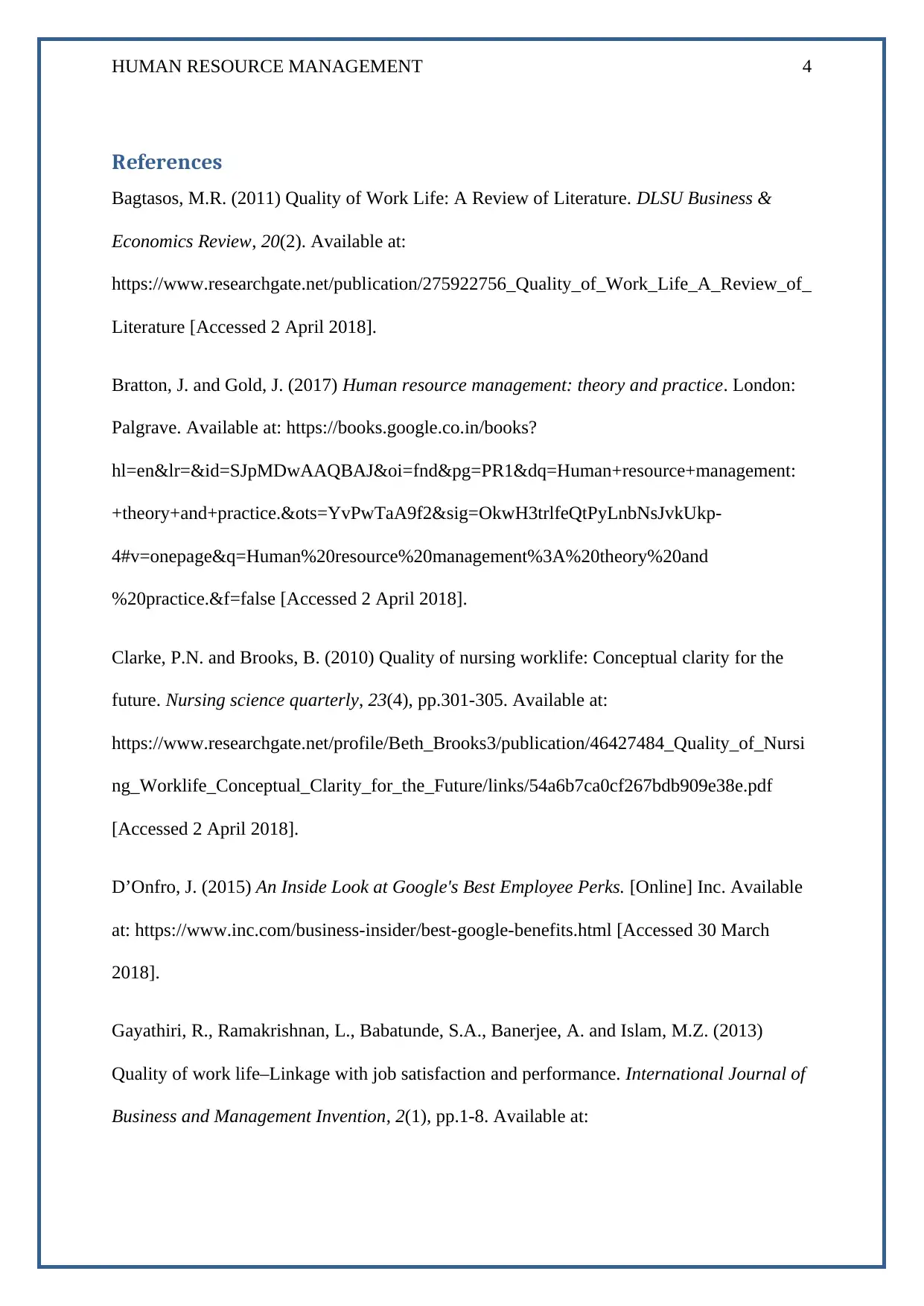
HUMAN RESOURCE MANAGEMENT 4
References
Bagtasos, M.R. (2011) Quality of Work Life: A Review of Literature. DLSU Business &
Economics Review, 20(2). Available at:
https://www.researchgate.net/publication/275922756_Quality_of_Work_Life_A_Review_of_
Literature [Accessed 2 April 2018].
Bratton, J. and Gold, J. (2017) Human resource management: theory and practice. London:
Palgrave. Available at: https://books.google.co.in/books?
hl=en&lr=&id=SJpMDwAAQBAJ&oi=fnd&pg=PR1&dq=Human+resource+management:
+theory+and+practice.&ots=YvPwTaA9f2&sig=OkwH3trlfeQtPyLnbNsJvkUkp-
4#v=onepage&q=Human%20resource%20management%3A%20theory%20and
%20practice.&f=false [Accessed 2 April 2018].
Clarke, P.N. and Brooks, B. (2010) Quality of nursing worklife: Conceptual clarity for the
future. Nursing science quarterly, 23(4), pp.301-305. Available at:
https://www.researchgate.net/profile/Beth_Brooks3/publication/46427484_Quality_of_Nursi
ng_Worklife_Conceptual_Clarity_for_the_Future/links/54a6b7ca0cf267bdb909e38e.pdf
[Accessed 2 April 2018].
D’Onfro, J. (2015) An Inside Look at Google's Best Employee Perks. [Online] Inc. Available
at: https://www.inc.com/business-insider/best-google-benefits.html [Accessed 30 March
2018].
Gayathiri, R., Ramakrishnan, L., Babatunde, S.A., Banerjee, A. and Islam, M.Z. (2013)
Quality of work life–Linkage with job satisfaction and performance. International Journal of
Business and Management Invention, 2(1), pp.1-8. Available at:
References
Bagtasos, M.R. (2011) Quality of Work Life: A Review of Literature. DLSU Business &
Economics Review, 20(2). Available at:
https://www.researchgate.net/publication/275922756_Quality_of_Work_Life_A_Review_of_
Literature [Accessed 2 April 2018].
Bratton, J. and Gold, J. (2017) Human resource management: theory and practice. London:
Palgrave. Available at: https://books.google.co.in/books?
hl=en&lr=&id=SJpMDwAAQBAJ&oi=fnd&pg=PR1&dq=Human+resource+management:
+theory+and+practice.&ots=YvPwTaA9f2&sig=OkwH3trlfeQtPyLnbNsJvkUkp-
4#v=onepage&q=Human%20resource%20management%3A%20theory%20and
%20practice.&f=false [Accessed 2 April 2018].
Clarke, P.N. and Brooks, B. (2010) Quality of nursing worklife: Conceptual clarity for the
future. Nursing science quarterly, 23(4), pp.301-305. Available at:
https://www.researchgate.net/profile/Beth_Brooks3/publication/46427484_Quality_of_Nursi
ng_Worklife_Conceptual_Clarity_for_the_Future/links/54a6b7ca0cf267bdb909e38e.pdf
[Accessed 2 April 2018].
D’Onfro, J. (2015) An Inside Look at Google's Best Employee Perks. [Online] Inc. Available
at: https://www.inc.com/business-insider/best-google-benefits.html [Accessed 30 March
2018].
Gayathiri, R., Ramakrishnan, L., Babatunde, S.A., Banerjee, A. and Islam, M.Z. (2013)
Quality of work life–Linkage with job satisfaction and performance. International Journal of
Business and Management Invention, 2(1), pp.1-8. Available at:
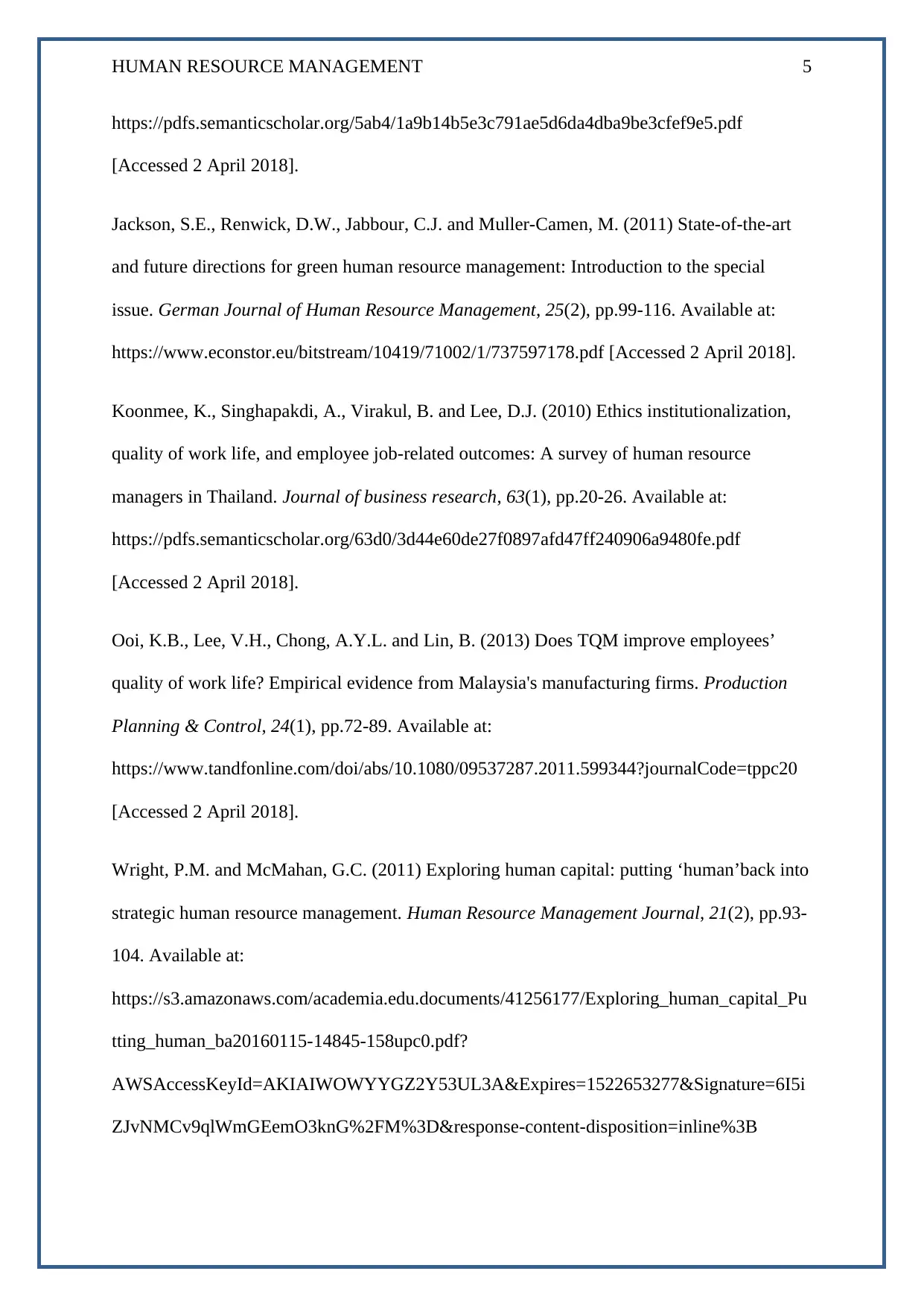
HUMAN RESOURCE MANAGEMENT 5
https://pdfs.semanticscholar.org/5ab4/1a9b14b5e3c791ae5d6da4dba9be3cfef9e5.pdf
[Accessed 2 April 2018].
Jackson, S.E., Renwick, D.W., Jabbour, C.J. and Muller-Camen, M. (2011) State-of-the-art
and future directions for green human resource management: Introduction to the special
issue. German Journal of Human Resource Management, 25(2), pp.99-116. Available at:
https://www.econstor.eu/bitstream/10419/71002/1/737597178.pdf [Accessed 2 April 2018].
Koonmee, K., Singhapakdi, A., Virakul, B. and Lee, D.J. (2010) Ethics institutionalization,
quality of work life, and employee job-related outcomes: A survey of human resource
managers in Thailand. Journal of business research, 63(1), pp.20-26. Available at:
https://pdfs.semanticscholar.org/63d0/3d44e60de27f0897afd47ff240906a9480fe.pdf
[Accessed 2 April 2018].
Ooi, K.B., Lee, V.H., Chong, A.Y.L. and Lin, B. (2013) Does TQM improve employees’
quality of work life? Empirical evidence from Malaysia's manufacturing firms. Production
Planning & Control, 24(1), pp.72-89. Available at:
https://www.tandfonline.com/doi/abs/10.1080/09537287.2011.599344?journalCode=tppc20
[Accessed 2 April 2018].
Wright, P.M. and McMahan, G.C. (2011) Exploring human capital: putting ‘human’back into
strategic human resource management. Human Resource Management Journal, 21(2), pp.93-
104. Available at:
https://s3.amazonaws.com/academia.edu.documents/41256177/Exploring_human_capital_Pu
tting_human_ba20160115-14845-158upc0.pdf?
AWSAccessKeyId=AKIAIWOWYYGZ2Y53UL3A&Expires=1522653277&Signature=6I5i
ZJvNMCv9qlWmGEemO3knG%2FM%3D&response-content-disposition=inline%3B
https://pdfs.semanticscholar.org/5ab4/1a9b14b5e3c791ae5d6da4dba9be3cfef9e5.pdf
[Accessed 2 April 2018].
Jackson, S.E., Renwick, D.W., Jabbour, C.J. and Muller-Camen, M. (2011) State-of-the-art
and future directions for green human resource management: Introduction to the special
issue. German Journal of Human Resource Management, 25(2), pp.99-116. Available at:
https://www.econstor.eu/bitstream/10419/71002/1/737597178.pdf [Accessed 2 April 2018].
Koonmee, K., Singhapakdi, A., Virakul, B. and Lee, D.J. (2010) Ethics institutionalization,
quality of work life, and employee job-related outcomes: A survey of human resource
managers in Thailand. Journal of business research, 63(1), pp.20-26. Available at:
https://pdfs.semanticscholar.org/63d0/3d44e60de27f0897afd47ff240906a9480fe.pdf
[Accessed 2 April 2018].
Ooi, K.B., Lee, V.H., Chong, A.Y.L. and Lin, B. (2013) Does TQM improve employees’
quality of work life? Empirical evidence from Malaysia's manufacturing firms. Production
Planning & Control, 24(1), pp.72-89. Available at:
https://www.tandfonline.com/doi/abs/10.1080/09537287.2011.599344?journalCode=tppc20
[Accessed 2 April 2018].
Wright, P.M. and McMahan, G.C. (2011) Exploring human capital: putting ‘human’back into
strategic human resource management. Human Resource Management Journal, 21(2), pp.93-
104. Available at:
https://s3.amazonaws.com/academia.edu.documents/41256177/Exploring_human_capital_Pu
tting_human_ba20160115-14845-158upc0.pdf?
AWSAccessKeyId=AKIAIWOWYYGZ2Y53UL3A&Expires=1522653277&Signature=6I5i
ZJvNMCv9qlWmGEemO3knG%2FM%3D&response-content-disposition=inline%3B
⊘ This is a preview!⊘
Do you want full access?
Subscribe today to unlock all pages.

Trusted by 1+ million students worldwide
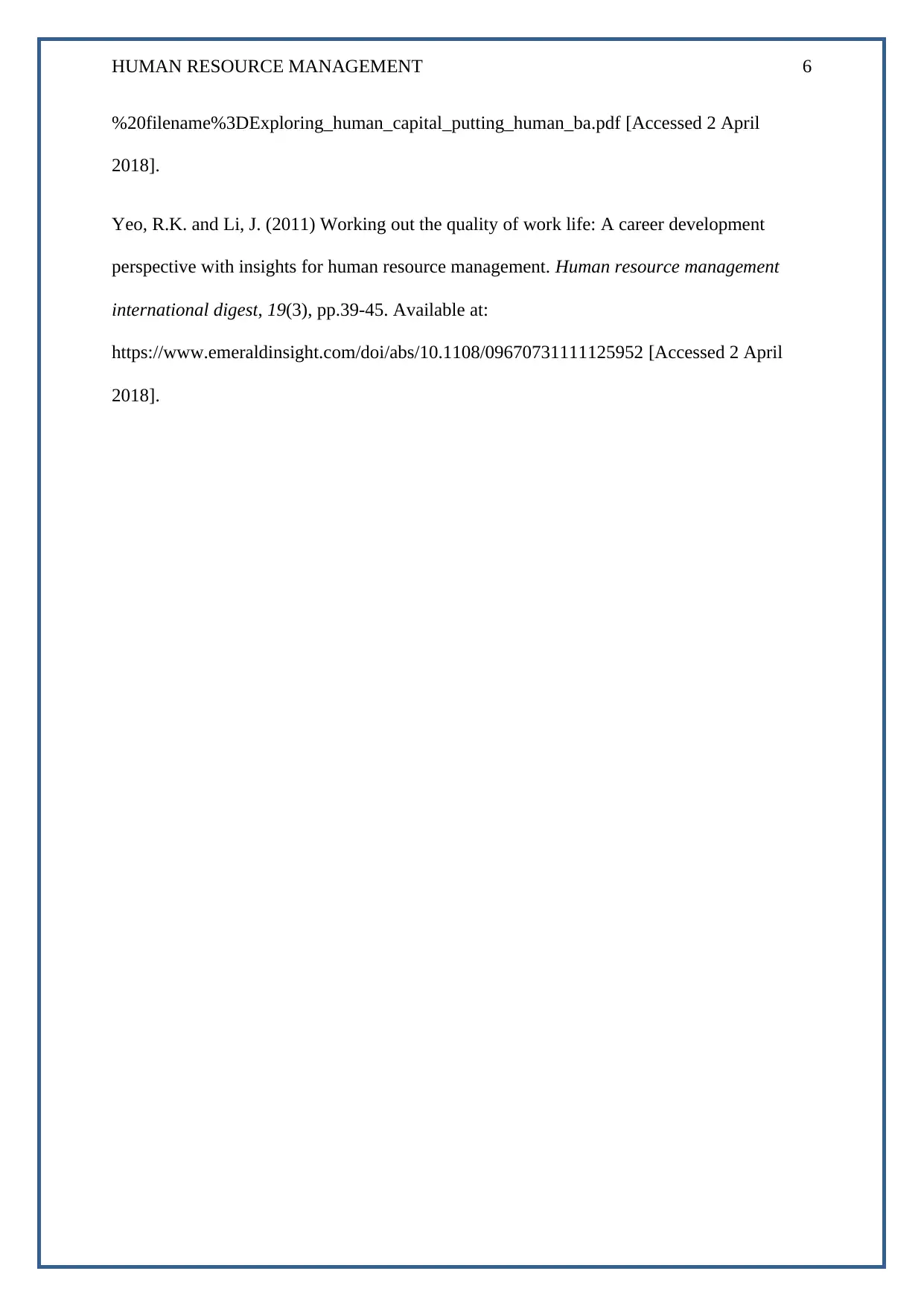
HUMAN RESOURCE MANAGEMENT 6
%20filename%3DExploring_human_capital_putting_human_ba.pdf [Accessed 2 April
2018].
Yeo, R.K. and Li, J. (2011) Working out the quality of work life: A career development
perspective with insights for human resource management. Human resource management
international digest, 19(3), pp.39-45. Available at:
https://www.emeraldinsight.com/doi/abs/10.1108/09670731111125952 [Accessed 2 April
2018].
%20filename%3DExploring_human_capital_putting_human_ba.pdf [Accessed 2 April
2018].
Yeo, R.K. and Li, J. (2011) Working out the quality of work life: A career development
perspective with insights for human resource management. Human resource management
international digest, 19(3), pp.39-45. Available at:
https://www.emeraldinsight.com/doi/abs/10.1108/09670731111125952 [Accessed 2 April
2018].
1 out of 7
Related Documents
Your All-in-One AI-Powered Toolkit for Academic Success.
+13062052269
info@desklib.com
Available 24*7 on WhatsApp / Email
![[object Object]](/_next/static/media/star-bottom.7253800d.svg)
Unlock your academic potential
Copyright © 2020–2025 A2Z Services. All Rights Reserved. Developed and managed by ZUCOL.





